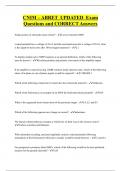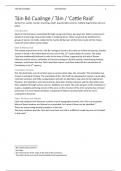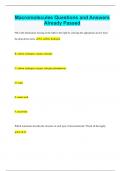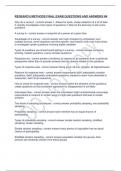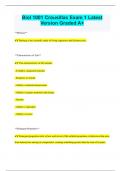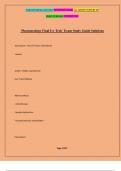EXAM PREP
2022
, Stuvia.com - The study-notes marketplace
EXAM PREP
Exam Paper: Time – 2 hours Total 100 marks
Material to study:
Assignment 1
Assignment 2
Assignment 3
Read through the study guide & prescribed book
Lay out of the exam paper: 5 Questions – 20 marks each
o Question 1 – multiple choice questions
o Question 2 – 5: Each question consists of short & paragraph type questions
: Factual as well as application questions
Summaries & explanations relating to options to the Qs in assign 1.
# 1.2 SOCIALISATION MODELS: learner profile reflects community & wider society education serves
i) assimilation: acceptance of a minor group by major pop in which minor group takes over values &
norms of de dominant culture completely. A+B+C=A
ii) amalgamation / melting-pot model: creation & development of entirely, unique, distinctive culture into
new homogenous society by eradicating cultural differences through education. A+B+C=D
iii) open society ideology: individual interests given priority by rejecting any basis upon which group are
formed, eg. ethnicity, faith, language etc. A+B+C=O
1.2.1Culturally Pluralistic Models: relate to cultural, religious, ethnically diverse society where several
ethnic groupings co-exist, each living in communities separate from each other.
i) structural pluralism / classic cultural / external / isolated / vertical pluralism: process where no inter-
group contact is promoted, by accepting cultural pluralism as part of a modern city, but advocating
separate development of structural& institutional systems like education, language, legal systems
etc. A+B+C = A+B+C
ii) modified cultural pluralism: acknowledges cultural diversity but favours greater interaction between
different groups. A+B+C = A1+B1+C1 ( 1s represent same group after change due to reciprocal
influencing takes place)
iii) dynamic cultural pluralism is an expanded form of MCP, acknowledging importance of individual
ethnic identity of groups, but considers emphasis on this too narrow / restrictive for free group
formation. Cultural diversity is recognised with an outlook to free association /interaction between
groups on basis of politics, race, ethnicity, language, socio-economics etc. so as to gear towards
social concerns & solving community problems.
#1.3.1.3 ATTEMPTS TO PROMOTE INTEGRATION: plans to desegregate schools
i) “Pairing & Clustering” : “pairing”= white & black schools were joined through cooperative agreement,
where white & black learners were taught together up to a certain grade in a white school &
thereafter at the black school or vice versa.
“clustering” = same thing but more than one school collaborated in this way.
ii) “Busing”: (system of bus transport) = learners conveyed from one neighborhood to others so as to
ensure a specific race ratio. New school board boundaries established where they were allowed to
accommodate only certain grades, & sites for new schools chosen so parents were obliged to send
to specific schools so that race ratio is in proportion.
iii) “ magnet schools/ educatuional parks: attempt to promote voluntary integration by offering education
of outstanding quality in a bid to convince parents to enroll their kids at the school.
iv) Supplementary education: by arranging smaller classes & making available English revision
textbooks, psychologists & social workers in a bid to aid black learners to adjust & fully integrate
into new desegregated educational dispensation.
Downloaded by: rishmanyar |
Distribution of this document is illegal
, Stuvia.com - The study-notes marketplace
# CONCEPT OF MULITICULTURAL EDUC>
# CONCEPT OF CULTURE
# MACROCULTURE & MICRO OR SUB-CULTURE
Macroculture =dominant culture of a nation generally shared by all.
In SA macroculture- dominant group, but not shared by all due to history of separatism through apartheid.
Microculture = classroom, office, religious/sports group> where values, rules etc shared by group members.
In SA, although microcultures have become isolated they are not isolated per se since people
interact & overlap through several microcultures.
#
#
o
o
o These
o issued to quell educational unrest of the 70s
o
o
o
Downloaded by: rishmanyar |
Distribution of this document is illegal
, Stuvia.com - The study-notes marketplace
# LEARNING STYLES
Factors that make up our learning environment:
o Enviromental Factors: effects of sound, light, weather, place specifics in classroom
o Emotional Factors: motivated by extrinsic rewards: prizes, or Fear of punishment,
Intrinsic factors: dislike /enjoyment of specific subject
Differing levels of persistence, variables affecting concentration on tasks
Views on accountability of success & failure: accepting or calling it ‘luck’
Structural needs of learners:
o Pschyological Factors: distinguish between Analytic learners: learners who break down learning
material to understand it.
& Global learners: build an overall picture of the content
Reflective learners: think before answering / take time…
& Impulsive learners: answer on the turn / quickly
o Sociological Factors: preference of group work
Or Buddy system: working with another learner
Teamwork: stimulated by collaborative teamwork & competition between teams
o Physical Factors: differences in choice of Sensory input for learning style: Auditory: vocal discussns
Visual: pics, diagrams, chalkboard Tactile-Kinesthetic: experiments, building, using hands etc.
o Field Dependent Learner: prefer global, holistic, relational approach to learning
Peer Relationship: likes to work with others to Achieve common goal; helps / sensitive to othrs feelings
Educator Re.: expres warm feelings for ed. & asks qs about his/her likes; dislikes; personal feelings
Instructional Re.: seeks guidanc/demonstratn frm ed. & personal rewards dat strengthen relatn with ed.
Highly motivated when working individually with ed.
Cognitive Style: functions well when aims carefully explained/ demonstrated prior to lesson activity &
curriculum content is made relevant to personal interests & experiences
Deals well with concepts in story/humanized form & has Preference for concrete visual images.
o Field Independent Learner: display a more analytic, verbal, sequential style
Peer Relationship: likes to work independently & compete with others & gain recognitn for achievement
: Is task orientated & not socially dependent when working.
Educator Re.: rarely seeks physical contact with ed.
& restricts formal interactions with ed. to tasks at hand.
Instructional Re.: likes to risk & try new tasks without ed’s help; impatient to begin tasks& complete 1st
: Seeks non-social rewards
Cognitive Style: likes to break up learning content & enjoys discovery approach.
Stresses details of concepts & regards parts to have meaning on their own.
Downloaded by: rishmanyar |
Distribution of this document is illegal


